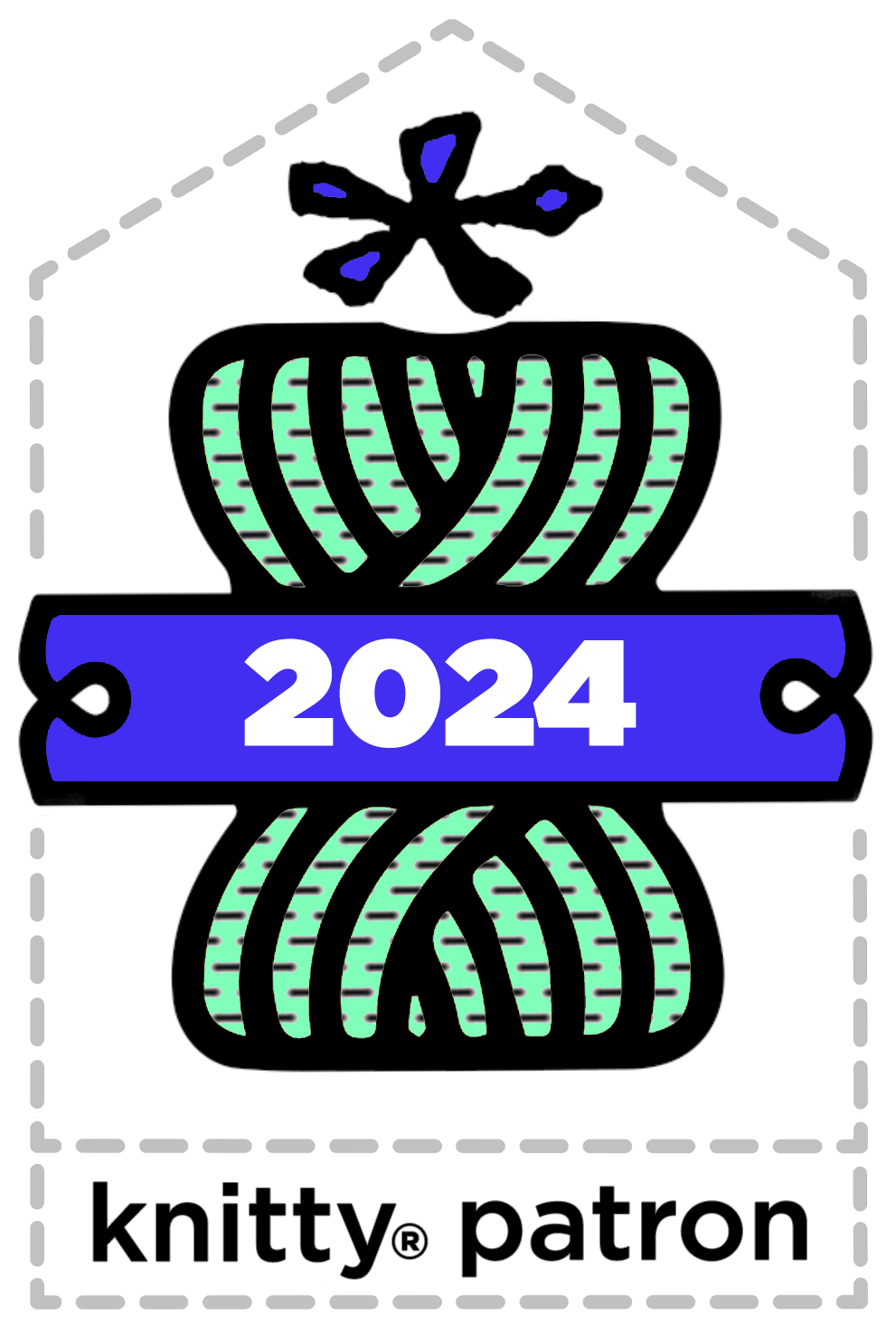Peri Peri, a free knitting pattern from Knitty.com. Free knitting pattern for a DETAILS HERE.
INTRODUCTION
Peri Peri
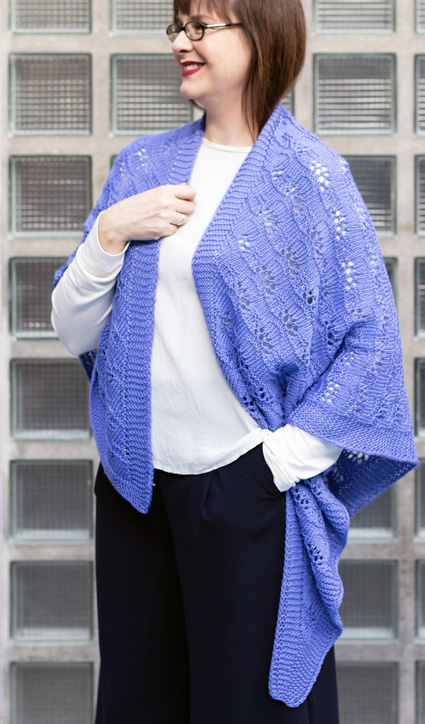 by Valentina Cosciani (Tibisay)
by Valentina Cosciani (Tibisay)
![]()
"Peri Peri" (which means "to go around" in Sicilian dialect) is an asymmetrical shawl with an unusual shape, knit in a simple stitch pattern which decorates the entire width of the shawl. The lace pattern is a variant of an old Shetland lace stitch called "Feather and Fan" and I like it very much because its harmonious shapes remind me of the weaves of the Mediterranean sea.
You start knitting from the narrow tip of the shawl and the increases are positioned only on one side of the shawl, giving it an asymmetrical triangle shape. The shawl can be made as long or as short as you want, depending on how much yarn you have. The shawl is finished with I-cord borders for a tailored look.
 model: Valentina Cosciani
model: Valentina Cosciani
 photos: Paolo Bonivento
photos: Paolo Bonivento
SIZE
One
FINISHED MEASUREMENTS
Long Edge: 76.5 inches/194 cm
Deep: 37 inches/93cm
MATERIALS
Yarn
![]() LANA GATTO Feeling [70% Wool [Merino], 20% Silk and 10% Cashmere; 153 yd/50 m per 1.76 oz/50 g ball]; color: 13605 (blue); 6 balls
LANA GATTO Feeling [70% Wool [Merino], 20% Silk and 10% Cashmere; 153 yd/50 m per 1.76 oz/50 g ball]; color: 13605 (blue); 6 balls
Recommended needle size
[always use a needle size that gives you the gauge listed below - every knitter's gauge is unique]
![]() US 7/4.5 mm needles for working flat – a long circular is easiest
US 7/4.5 mm needles for working flat – a long circular is easiest
Notions
![]() a needle in a size or two larger, for bind off (optional, see bind off instructions)
a needle in a size or two larger, for bind off (optional, see bind off instructions)
![]() yarn needle
yarn needle
![]() pins and mats for blocking; wires if you have them
pins and mats for blocking; wires if you have them
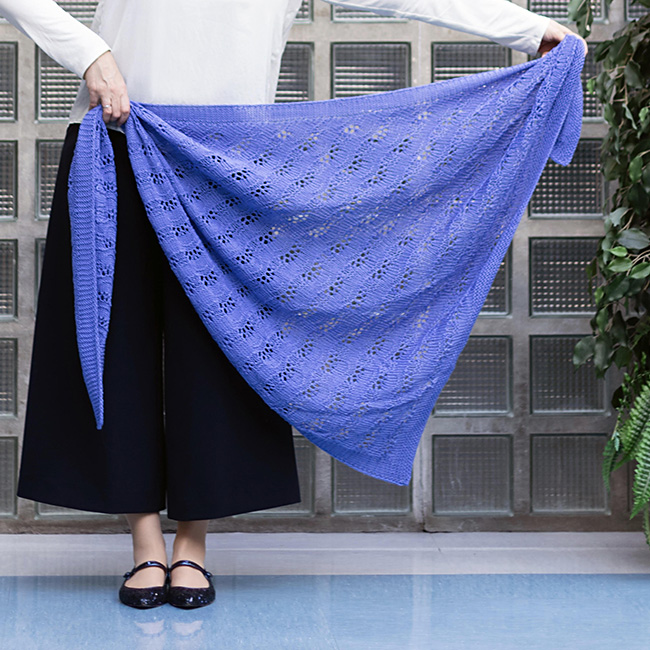
GAUGE
Approximately 23 sts/28 rows = 4 inches/10 cm in stockinette stitch
16 sts/24 rows = 4 inches/10 cm in lace stitch.
PATTERN NOTES
[Knitty's list of standard abbreviations and techniques can be found here.]
The knitting starts from the narrow end of the shawl. It is easy to adjust the length based on how much yarn you have.
Lace Pattern Setup
Work from chart or written instructions as you prefer.
Row 1 (RS): K to last 10 sts, kfb, k to last 2 sts, sl 2 wyif. 1 st increased.
Rows 2, 4, 6, 10 and 16 (WS): K10, p to last 9 sts, k7, sl 2 wyif.
Row 3: K to last 10 sts, kfb, k to last 2 sts, sl 2 wyif. 1 st increased.
Row 5: K12, p3, kfb, k to last 2 sts, sl 2 wyif. 1 st increased.
Row 7: K to last 10 sts, kfb, k to last 2 sts, sl 2 wyif. 1 st increased.
Row 8: K to last 2 sts, sl 2 wyif.
Row 9: K9, k2tog twice, yo, k1, yo, k to last 10 sts, kfb, k to last 2 sts, sl 2 wyif. 1 st increased.
Row 11: K9, k2tog twice, yo, k1, yo, k4, kfb, k to last 2 sts, sl 2 wyif. 1 st increased.
Row 12: K10, p to last 10 sts, k to last 2 sts, sl 2 wyif.
Row 13: K to last 10 sts, kfb, k to last 2 sts, sl 2 wyif. 1 st increased.
Row 14: Repeat Row 12.
Row 15: K to last 10 sts, kfb, k to last 2 sts, sl 2 wyif. 1 st increased.
Row 16: Repeat Row 2.
Lace Pattern Repeat
Work from chart or written instructions as you prefer.
Row 1 (RS): K9, [k3, p5, k4] to last 10 sts, kfb, k7, sl 2 wyif. 1 st increased.
Row 2 (WS): K10, p to last 9 sts, k7, sl 2 wyif.
Row 3: K to last 10 sts, kfb, k7, sl 2 wyif. 1 st increased.
Row 4: K to last 2 sts, sl 2 wyif.
Row 5: K9, [k2tog twice, (yo, k1) three times, yo, ssk twice, k1] to last 12 sts, k2, kfb, k7, sl 2 wyif. 1 st increased.
Row 6: Repeat Row 2.
Row 7: K9, [k2tog twice, (yo, k1) three times, yo, ssk twice, k1] to last 13 sts, k3, kfb, k7, sl 2 wyif. 1 st increased.
Row 8: K10, p3, k1, [k2, p9, k1] to last 9 sts, k7, sl 2 wyif.
Row 9: Repeat Row 3. 1 st increased.
Row 10: K10, p4, k1, [k2, p9, k1] to last 9 sts, k7, sl 2 wyif.
Row 11: Repeat Row 3. 1 st increased.
Row 12: Repeat Row 2.
Row 13: K9, [k3, p5, k4] to 16 sts, k6, kfb, k7, sl 2 wyif. 1 st increased.
Row 14: Repeat Row 2.
Row 15: Repeat Row 3. 1 st increased.
Row 16: Repeat Row 4.
Row 17: K9, [k2tog twice, (yo, k1) three times, yo, ssk twice, k1] to last 18 sts, k2tog twice, yo, k1, yo, k3, kfb, k7, sl 2 wyif. 1 st increased.
Row 18: Repeat Row 2.
Row 19: K9, [k2tog twice, (yo, k1) three times, yo, ssk twice, k1] to last 19 sts, k2tog twice, yo, k1, yo, k4, kfb, k7, sl 2 wyif. 1 st increased.
Row 20: K10, p9, k1, [k2, p9, k1] to last 9 sts, k7, sl 2 wyif.
Row 21: Repeat Row 3. 1 st increased.
Row 22: K10, p10, k1, [k2, p9, k1] to last 9 sts, k7, sl 2 wyif.
Row 23: Repeat Row 3. 1 st increased.
Row 24: Repeat Row 2.
CHARTS
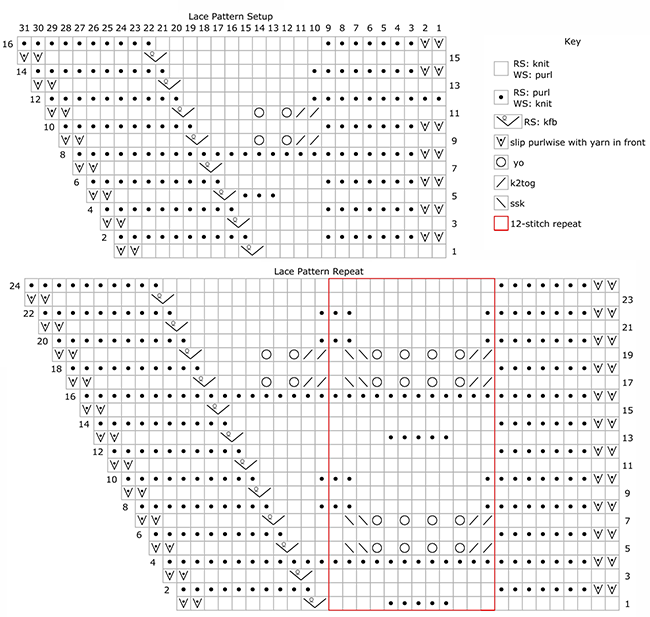
DIRECTIONS
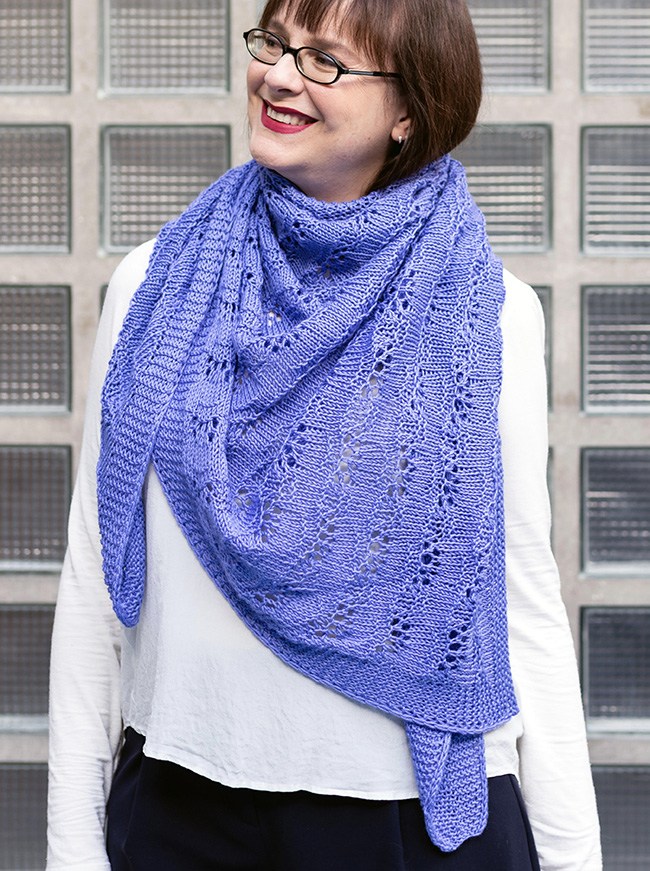
METHOD
Section 1:
CO 10 sts.
Row 1 [RS]: K5, kfb, k to last 2 sts, sl 2 wyif. 1 st increased.
Row 2 and all even rows [WS]: K to last 2 sts, sl 2 wyif.
Rows 3 and 5: K6, kfb, k to last 2 sts, sl 2 wyif. 1 st increased.
Rows 7, 9 and 11: K7, kfb, k to last 2 sts, sl 2 wyif. 1 st increased.
Rows 13, 15 and 17: K8, kfb, k to last 2 sts, sl 2 wyif. 1 st increased.
Rows 19, 21, 23 and 25: K to last 10 sts, kfb, k7, sl 2 wyif. 1 st increased. 23 sts at the end of row 25.
Row 26: Repeat Row 2.
Section 2:
Following the chart or written instructions, work Lace Pattern Setup. 31 sts.
Section 3:
Following the chart or written instructions, work Lace Pattern Repeat. Shawl as shown has 13 repeats of this pattern, 187 sts. You can adjust the dimensions of the shawl based on your personal preference or on the amount of yarn you have, by working these rows (1 – 24) as many or as few times needed, ending with Row 12 or 24.
Section 4 (garter stitch):
Rows 1-12: K to last 2 sts, sl2 wyif.
BO all sts, keeping edge loose. Use the larger needle to work the stitches as you go, if you wish.
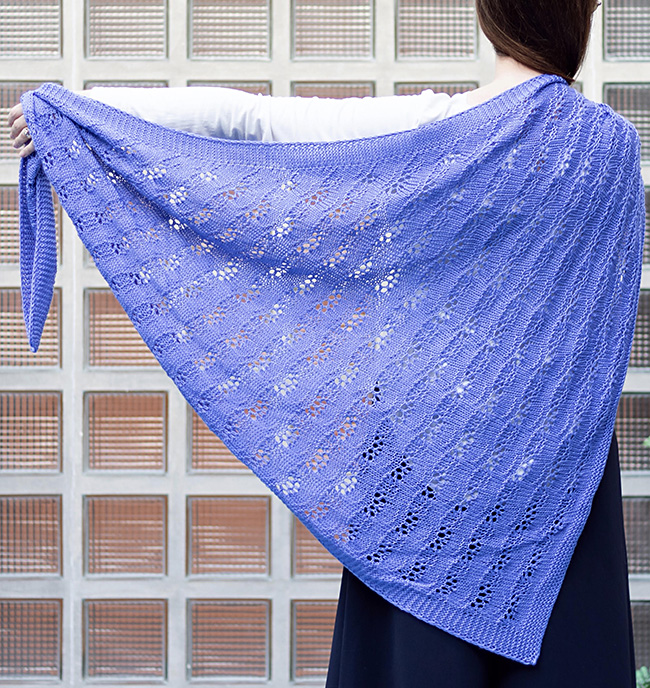
FINISHING
Weave in ends and block aggressively, as follows:
Wash the shawl in cold water with a small amount of gentle detergent; rinse. Squeeze the shawl between your hands, without twisting, to remove most of the water.
Spread the shawl out on a large towel and roll it up into a cylindrical form, then press it well to remove all of the excess water. Unroll the towel and spread the shawl out on a large, flat, soft surface that you can poke the pins into.
Stretch the shawl aggressively and pin or use blocking wires.
Allow to dry.
ABOUT THE DESIGNER
 Valentina Cosciani (alias TIBISAY) lives and works in Trieste (Italy) with her husband, two sons, and two cats. She spends most of her time designing patterns, writing her blog, and making videos for her YouTube channel.
Valentina Cosciani (alias TIBISAY) lives and works in Trieste (Italy) with her husband, two sons, and two cats. She spends most of her time designing patterns, writing her blog, and making videos for her YouTube channel.
She desperately tries to fit together the pieces of a chaotic daily routine that includes knitting, traveling in Italy, Austria and Switzerlandto present new designs, and cooking for the famished men in her active family... failing more often than not!
Find her here on Ravelry.
Pattern & images © 2020 Valentina Cosciani (Tibisay).







